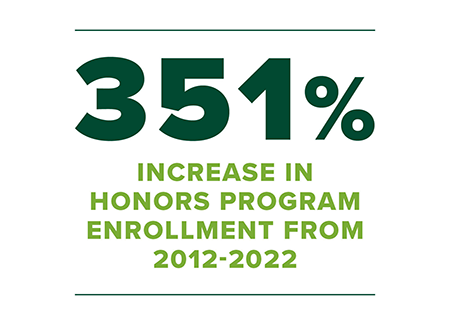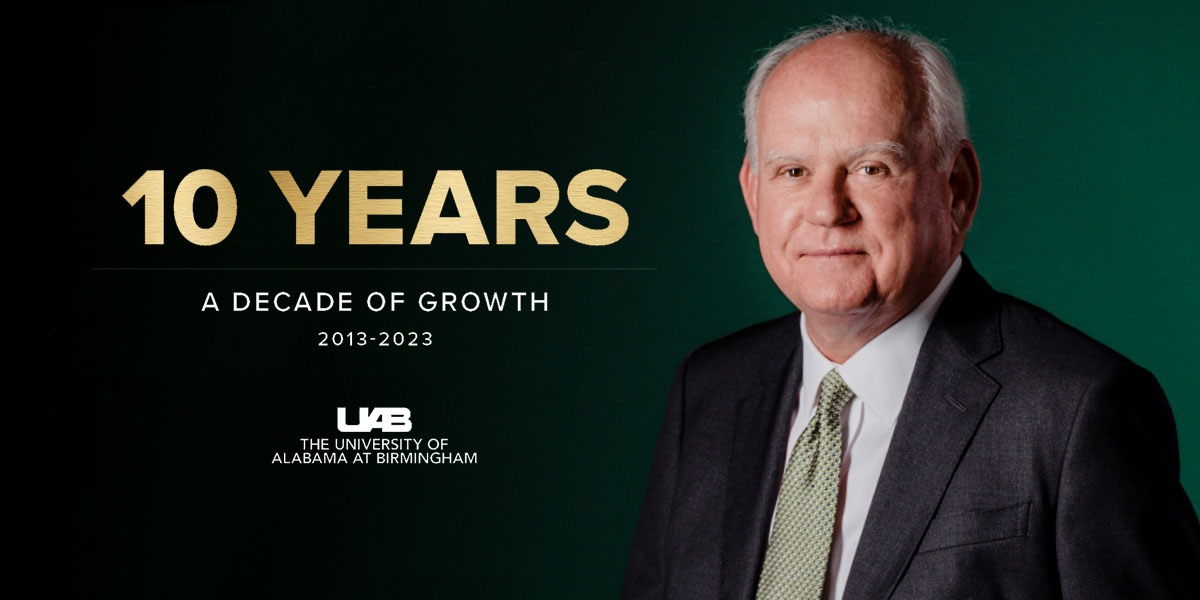Success at an enterprise as large and complex as the University of Alabama at Birmingham requires vision, purposeful planning and determination. It also takes leadership and teamwork.
A decade ago, when the nation was still working its way through the aftershocks of the 2007-2009 Great Recession, and Ray L. Watts, M.D., was named UAB’s seventh president, the time was ripe for audacious goals, aggressive investments and dramatic change.
In 2023, the results are incontrovertible: UAB is bigger by every measure, more diverse than nearly every other peer institution and more prestigious than ever.
And to Watts, the most important thing is making more of a difference improving and saving people’s lives in Birmingham, Alabama and beyond. “With the full support and partnership of our Board and UA System Office, we are focused on growth, because that is how we continue to advance across all our missions,” said Watts, who hit his 10-year mark as UAB president in February, making him the longest-serving UAB president in the institution’s 53-year history.
“It is our mission to educate; to research, discover and create; to care for our patients; and to make our community a better place through our service. We strive for excellence in everything we do because the more success we have, the better, longer and happier are the lives of those we serve.”
A special March 2023 edition of UAB Magazine, released and available to view online
here, takes stock in UAB’s rapid growth in all facets over the past 10 years and where the institution is going. This month, UAB celebrates the institution’s achievements and will host an event for employees and students from 11 a.m.-1 p.m., March 22, on the Campus Green, at which time Watts will thank the UAB community for a great decade.
University of Alabama System Chancellor Finis St. John — a trustee on the UA System Board of Trustees at the time Watts was named president — takes pride in reflecting on UAB’s success under Watts.
“In the 10 years since the Board of Trustees named Watts president, he has led UAB to unprecedented and monumental success — along with dedicated and talented students, faculty, staff, and passionate alumni, donors and fans,” St. John said. “Under his leadership, UAB is realizing its endless potential. We knew President Watts was the right person to take the university and Health System to new heights, and that is precisely what he has done with the full support of our System Office and Board.”
Certainly, when the past 10 years are examined, the positive impact of the institution is undeniable.
Economic impact: When Watts was named president in 2013, the institution’s annual economic impact was an estimated $4.6 billion, as outlined in a 2008 report. By 2016, it had reached $7.15 billion. According to a report analyzing UAB’s 2022 fiscal year, the institution’s economic impact has grown to $12.1 billion a year — representing a $7.5 billion, 163 percent increase since the 2008 report. “UAB is the most significant single contributor to the Alabama economy and the leading generator of jobs,” stated a 2023 report by Tripp Umbach.
Education and enrollment: As part of the
2017 Strategic Plan Forging the Future, UAB sought to leverage its existing strengths and continue to develop new programs that would appeal to the students and prepare them for the modern workforce. Unique programs were developed that created opportunities for students and enhanced UAB’s national and global reputation. Biomedical engineering, medical sociology and music technology programs were launched, among others, which led to undergraduate degrees in bioinformatics, cancer biology, genetics and genomic sciences, immunology, and neuroscience offered jointly by the
College of Arts and Sciences and the
Heersink School of Medicine.
UAB was also named the No. 1 Young University in the U.S. by Times Higher Education
in 2018 and 2019 — a testament, Watts says, to the dedication and hard work of the institution’s students, faculty, staff, alumni and community supporters.
Research, innovation and economic development: Research funding has exploded since 2013, increasing 89 percent from $379 million in fiscal year 2013 to $715 million in fiscal year 2023. This puts the institution in the top 1 percent of all public, private and international organizations funded by the National Institutes of Health. But the real story is not the money — it is the impact.
In Watts’ decade as president, the institution has brought in $5.3 billion in research funding. “The goal is not just to have more research dollars, but to have more research accomplishments that we know will positively impact the lives of people,” Watts said. “Cutting-edge research, education and training helps tackle major health problems facing all Alabamians and beyond and leads directly to breakthroughs that impact patient care in the areas of greatest need.”
The Health System has entered into affiliation or management agreements with 13 hospitals since 2013 to improve care and access across Alabama. And UAB’s
O’Neal Comprehensive Cancer Center remains the only National Cancer Institute-designated cancer center in a four-state region.
Telehealth infrastructure has been greatly expanded to aid Alabama’s chronic struggle with patient access, and it became a key component of care provided when the COVID-19 pandemic hit the state in 2020.
UAB provided COVID vaccines to people in all 67 Alabama counties and established COVID testing and vaccination sites in Birmingham and surrounding communities.
“UAB Medicine’s dedicated and talented team of health care professionals, support staff and leaders are caring for more patients than ever — not just in Birmingham, but across the state and beyond,” Watts said. “UAB Medicine and its people have earned a reputation for providing world-class care in state-of-the-art facilities.”
Community engagement: A centerpiece of UAB’s efforts in the community has been the university’s Grand Challenge —
Live HealthSmart Alabama — an ambitious goal to have a substantial, lasting impact on the well-being of Alabamians through cross-sector and multidisciplinary collaboration. With this effort, UAB aims to move Alabama out of the bottom 10 states in key national health rankings over a decade.
Since its launch, Live HealthSmart has partnered to transform neighborhoods by tackling policies, systems and infrastructure, from mobile stores to sidewalks and streetlights, that promote wellness, education and economic opportunities. To date, more than 100 corporate and community partners now support these efforts in Kingston, Titusville, East Lake, Bush Hills and north Birmingham neighborhoods.
UAB employees and students also continue to be generous with their time and resources in the community — and now there is a way to help identify, organize, promote and quantify activities ranging from volunteer projects to service-learning, community-based research and institutional outreach. UAB created a central hub —
BlazerPulse — to reduce barriers to community engagement and connect university expertise and effort with community needs and partners.
BlazerPulse enables users to create and manage volunteer communities and track, measure and share their impact. Its integration with Engage, a site used by Student Affairs to organize student volunteer efforts, and
Scholars@UAB, a site to help connect faculty and promote collaboration, simplifies access and reporting.
Athletics: The strategic planning process Watts launched in 2013 has guided UAB to record-breaking student enrollment, employment, economic impact, community service, research funding and discoveries, and patient care.
But those unprecedented gains did not come without growing pains and reflection that would ultimately fuel UAB’s success — in
Athletics and across every pillar of the institution’s mission.
“One of the most pivotal moments in my career was the experience — from 2014 to today — of my decision to discontinue and then reinstate UAB Football, Bowling and Rifle, and the positive impact of the lessons I learned,” Watts said. “That decision was early in my presidency and not made with the kind of robust dialogue and shared governance that has since propelled our institution to unprecedented success. As difficult as that time was for the UAB community, we came out stronger.”
Since then, Watts’ commitment to shared governance has been celebrated by Student Government Association presidents and Faculty Senate chairs, among others.
Mike Sloane, Ph.D., who joined the UAB faculty in 1982 and served as chair of the Faculty Senate during the height of the COVID pandemic, witnessed the decision and the return and often praises Watts’ collaborative leadership. During his 2021 presentation to the University of Alabama System Board of Trustees, Sloane said, “I have seen a group of leaders who cooperate to make data-driven decisions and seek input from all parties in order to establish conditions for the healthiest, safest and most productive environments for students, staff, faculty and patients …. UAB’s culture of shared governance has been established and is blossoming.”
The unprecedented dialogue, teamwork and community support for reinstatement convinced Watts that excellence was possible in the programs, and it showed the value of shared governance. “The collective brainpower, innovation and resolve across UAB, Birmingham and beyond are continuing to fuel our success,” Watts said.
Among other milestones since 2015, the Department of Athletics received more than $71 million in philanthropic support, reinstated UAB Football, Bowling and Rifle, built or renovated 25 facilities, and won seven conference championships and three bowl games. Blazer athletes’ graduation rate increased from 75 percent to 94 percent over the same time period, and the American Athletic Conference invited UAB to join its league beginning July 1, 2023 — a move that increases the visibility and competitiveness of UAB Athletics on a national stage.
The next decade
What do the next 10 years hold for UAB? In January 2022, Watts appointed a Strategic Planning Council to begin the process of refreshing the
Forging the Future strategic plan that has guided UAB’s growth for the past five years.
The council is reviewing data, conducting an environmental scan, examining initiatives at peer institutions, and reviewing mission pillars and foundations, with a goal of sharing and discussing the refreshed strategic plan with stakeholders in spring 2023, followed by a presentation to the University of Alabama Board of Trustees this summer.
At the same time, Watts and leaders in the Heersink School of Medicine and the UAB Health System are developing an updated clinical strategic plan.
In the middle of the COVID-19 pandemic, Forbes named UAB America’s No. 1 Best Large Employer for 2021 and its Best Employer for Diversity among colleges and universities.
While persistent growth across the board will continue to be a focus, another priority for the coming years will be continuing to transform UAB affiliate
Southern Research and accelerate scientific endeavors and economic development in Birmingham.
Southern Research is investing $108 million to modernize its Southside campus, including a biotech innovation center that will anchor an urban research park. UAB and Southern Research are also collaborating on biotech commercialization opportunities, combining UAB’s research expertise with the drug discovery and development capabilities of Southern Research. “We want to be the biotech commercialization hub for the Southeast United States,” Watts said.
While all of these plans are still evolving, Watts explains that impacting people in a positive way while continuing to grow UAB in all facets will continue to lead the agenda.
“What we do in pursuing our mission has a real impact on people,” Watts said. “Our presence in Birmingham makes our city stronger, and the work we do in education, research, public and global health, and community service impact people around the state, country and the world. That’s how I think about it. How are we impacting people? How are we serving them? We want to serve with compassion and caring and make everything we do about the human impact, the community impact and the economic impact.”
“The reason I took on the challenge of becoming president was to make sure UAB was doing everything possible to help the people of Birmingham, the state of Alabama and surrounding areas be the best they can be,” Watts said. “We’re going to be a dynamic, forward-looking institution dedicated to excellence in all parts of our mission, and our extraordinary students, faculty, staff, alumni, supporters and UA System leadership make that possible.”



